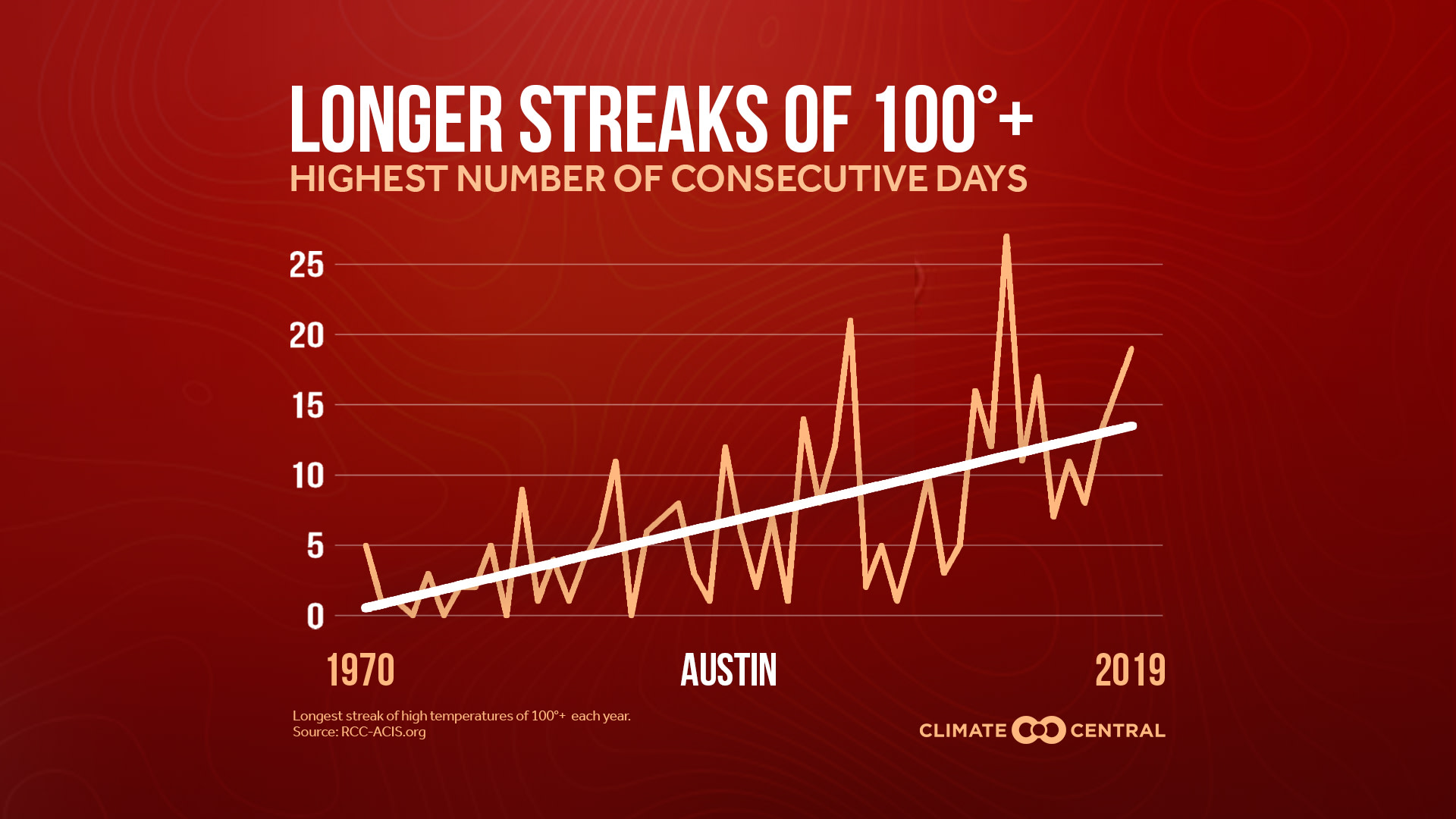KEY CONCEPTS
Extreme heat is taxing on our health, especially if we have prolonged exposure to heat and less opportunity for the body to recover. Our analysis of ‘heat streaks’ found that 74% (180) of the 242 cities analyzed are experiencing longer stretches of extreme heat compared to fifty years ago.
Of the top ten cities recording the biggest increase in their longest heat streak, nine were in Texas and all had increases of more than ten consecutive days.
Many U.S. cities are implementing novel heat adaptation strategies. These strategies are especially important for low-income communities, outdoor workers and communities of color who are often more exposed to extreme temperatures and have less access to air conditioning.
By the time August rolls around, much of the U.S. has passed what is typically their ‘hottest day’ of the year, trading the more intense heat of July for the sultry, hot stretches of August. Prolonged spells of heat are an important symptom of our changing climate because of their impact on our health. Extreme heat is taxing on our bodies, particularly when we’re exposed to long bouts and have less opportunity to recover.
Our analysis of ‘heat streaks’, or the number of consecutive hot days, shows that much of the country is experiencing longer stretches of extreme heat compared to fifty years ago. Of the 242 cities analyzed, 74% (180) recorded an increase in their longest heat streak of the year, with 41% (99) reporting an increase of at least two days. Of the top ten cities recording the biggest increases, nine were in Texas and all had increases of more than ten days.
Extreme heat presents a mounting challenge to public health, particularly as longer bouts of heat and warmer nights mean more stress on the body and potentially loss of sleep, too. Many U.S. cities are implementing novel heat adaptation strategies. These strategies are especially important for low-income communities, outdoor workers and communities of color who are often more exposed to extreme temperatures and have less access to air conditioning. For those with access, future air conditioning usage is expected to surge in response to the increasing cooling demand. Increased energy consumption for cooling underscores the importance of transitioning to clean energy sources. If we go on powering our air conditioners on fossil fuels, our climate will only get hotter! Breaking out of this vicious cycle and cutting emissions is the best way to get our warming climate to ‘chill out.’
POTENTIAL LOCAL NEWS ANGLES
How is heat and humidity changing in your area?
See how extreme heat index days have trended locally, in Climate Central’s 2019 report on heat and sports. For projections, check out this comprehensive map tool from the Union of Concerned Scientists.
How is heat affecting public health?
Extreme heat is the deadliest kind of hazardous weather. The Center for Disease Control (CDC) tracks health and heat data through its public health tracking network for 25 states and New York City. Summer heat and sun can also cause air stagnation, leading to an accumulation of ground-level ozone. Find out more about climate change and air quality from the American Lung Association, and check out their rankings of cleanest cities.
What work is being done to protect vulnerable populations?
Many efforts were discussed in Climate Central’s recent webinar on extreme heat and COVID-19. Related resources include an EPA guidebook for excessive heat response, stories and projects from ISeeChange, and example strategies from the National Integrated Heat Health Information System.
EXPERTS TO INTERVIEW
Local Experts
The National Weather Service (NWS) operates 122 local weather forecast offices across the country. Check in with the NWS office in your area to find out about any upcoming heat forecasts, heat advisories and excessive heat warnings. Find out what steps are being taken in your locality to beat the heat — ask local officials about your city’s heat response plan, and see if the EPA database on community responses to urban heat islands includes your area.
The SciLine service, 500 Women Scientists or the press offices of local universities may be able to connect you with local scientists who have expertise on extreme heat in your area. The American Association of State Climatologists is a professional scientific organization composed of all 50 state climatologists.
National Experts
Karin Gleason, Meteorologist - Monitoring Section, NOAA's National Centers for Environmental Information (NCEI), Center for Weather and Climate (CWC), Karin.L.Gleason@noaa.gov
Mona Sarfaty, MD MPH FAAFP, Executive Director, Medical Society Consortium on Climate and Health at the George Mason University Center for Climate Change Communication, msarfaty@gmu.edu
METHODOLOGY
Data was gathered via the Applied Climate Information System. Cooling degree days were calculated using the sum of the daily cooling degree days each year. Change in the number of days is based on linear regression. Climate Central's local analyses include 244 stations. However, for data summaries based on linear trends, only 242 stations are included due to large data gaps in St. Johnsbury, Vermont and Wheeling, West Virginia.
